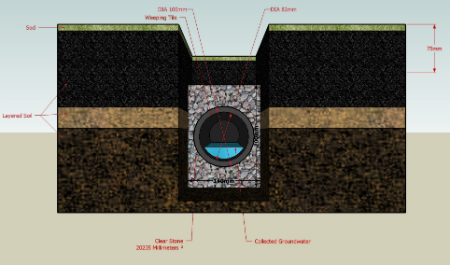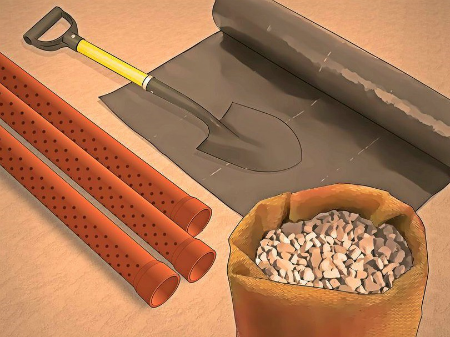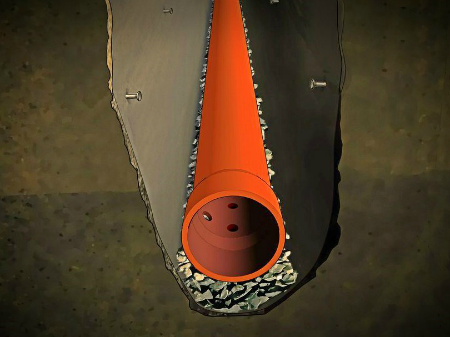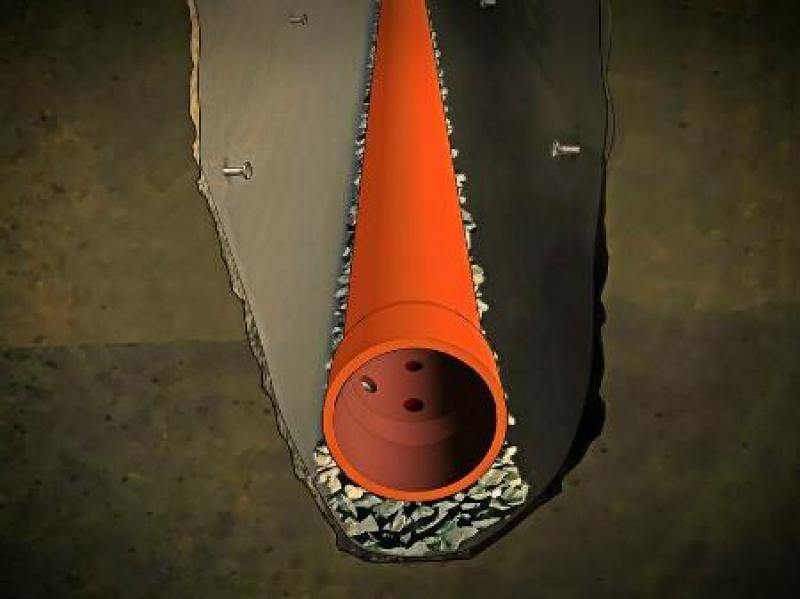What is a French Drain and How to Do It by Yourself?
by Scott Doyle on Nov 24, 2016
Being on terra firma means you need to pay special attention to ensuring your home is waterproof. One such method is the French drain, named after Henry Flagg French, a lawyer and former assistant U.S. treasury secretary from Concord, Massachusetts, who popularized the technique thanks to his book Farm Drainage (1859).
As a graduate of Dartmouth College and Harvard Law School, the French enjoyed more than just rules and regulations. He was an agriculture enthusiast and avidly experimented to increase scientific application to farming, particularly in the study of soil quality. The techniques used by farmers discussed in his published work, despite dating to nearly 160 years ago, still hold true today. The French drain is no exception.
Historical French drains were simply ditches, dug out from an area of elevation to lower ground, and filled in with gravel. At the time, French was constructing drains for his own farm and used roofing tiles in conjunction with a trench. Perforations were later added to these tiles with improvements in the process having been made over the years. French drains are now far more specialized than their predecessor, which is why they remain a popular waterproofing method for not only farmers, but homeowners too.
What is a French Drain and How Does It Work?
A French drain is simply a sloped trench that is lined with fabric with a pipe and gravel running through it. Its purpose is to steer water away from your home or other structures on your property.

Water naturally flows downhill, which is the route of least resistance. So during heavy rain, water will run into the gravel-filled trench before reaching the perforated pipe and flows through the pipe, away from your basement. The water is then emptied, whether it be on the street or in a drainage ditch.
A DIY French drain is quite easy. All it takes is a few materials: water-permeable landscape fabric, a perforated plastic drain, gravel or rock, and a shovel.

The process of building a French drain is not complicated, but careful attention is necessary. Work should begin on a downhill slope so that the trench can draw water away from your home just by the force of gravity. Before digging, think safety first. Locate any underground cables and pipes that run under the yard.
Then plan the route of your drain. Landscaping paint can help mark out the path. Make sure your runoff water doesn’t empty onto a neighbor’s land. Position it at least one meter away from walls and fences and steer clear of posts and plants like tree roots and shrubs. Depending on your municipality, digging may require paperwork. Consult your municipal office for information on the regulations about your neighborhood.
Once the above steps are completed, you can start digging your trench, the width and depth of which will depend on the severity of the drainage issue (consult with a professional). The standard size is about 15 centimeters (6 inches) wide and 46 to 61 centimeters (18 to 24 inches) deep. Hiring a surveyor or a professional specializing in waterproofing techniques to help with the planning stage is one way of ensuring you are on track.
Position the trench so that it is built on a downhill incline and regularly check you are digging in a downward direction. The trench is then lined with landscape fabric. Gravel is added, the pipe is fitted with the drain holes facing down and the opening covered.

At this point, you can be creative by adding a layer of decorative stones. Sometimes, people build their French drain at a slight curve to make the space look aesthetic.
Do You Need a French Drain?
This type of drain is an ideal solution for those with basements that are prone to flooding or have a soggy yard.
Basements: In this case, a deep French drain is recommended by professionals. With a trench running around the home’s perimeter, water is swiftly caught before flowing into your basement. Installation is also possible during and after home construction.
Yard: For an uneven yard, the drain does not need to be as deeply placed as in the case of wet basements. This type of French drain runs horizontally at a downhill inclination across the property.
Rain runoff, and many other waterlogged areas of your home.
From farmers to homeowners, the French drain has been lending a hand with water diversion for over 150 years. So whatever your waterproofing needs may be, when heavy rains wreak havoc on your basement or yard, this simple, yet effective solution can help. The issues that may surface with a DIY project can easily be mitigated with advice from a professional.
Popular Articles
Three Places to Spend Money on the Exterior of Your Home
When you have the exterior of your home remodeled, you are investing, time, energy and convenience into the project and you want to make sure that...
88778 Views
When to Use a Brush, Roller or Sponge Brush
Brushes are a good choice for painting trim and woodwork. They are also useful for cutting in the edges around the top and bottom edges and corners...
70041 Views
Homemade Headboards-Make an Upholstered or Wooden Headboard
Homemade headboards can add a lot of personality to any bedroom. They can be coordinated with existing furniture and room decor or they can be the...
69896 Views
Creating a Cottage Kitchen with Bead Board
Kitchen decor can range from modern and bold to elegant and elaborate by using strategic kitchen pieces. One of the most popular decorating trends...
48577 Views
Gas Fireplace Diagnostics and Troubleshooting
Follow these steps for diagnosing and troubleshooting Gas Fireplaces repairs. For the average DIYer, this may seem intimidating, depending on the...
29124 Views
Latest Articles
Understanding Indonesia’s Real Estate Investment Laws for Foreigners
Indonesia, with its stunning landscapes, deep-rooted cultural heritage, and renowned hospitality, has emerged as a top destination for foreigners...
on Jan 25, 2024
Real Estate Development in Asian Cities
In many Asian cities, the rapid pace of urban development has led to the decline of historic districts, areas once teeming with cultural richness...
on Jan 25, 2024
Shower Envy: Elevating Your Bathroom with a Stunning Walk-In Shower
Are you tired of the same old routine in your bathroom? It might be time to consider a change, and one way to elevate your bathroom to a new level...
on Jan 22, 2024
Exploring Crowdfunding as an Innovative Approach to Real Estate Investment
The landscape of property selling has been transformed significantly due to the advent of property crowdfunding. This innovative approach,...
on Jan 10, 2024
The Rise of Co-Living Spaces in Asian Cities
Asia, home to 21 of the worlds 30 largest cities, is a significant player in the global economy, contributing 38% of the goods and services of the...
on Jan 5, 2024
Featured Articles
What Type of Licensed Contractor Should You Hire?
on Feb 28, 2017
Hire Contractors / Estimates

Looking for a specialty project? There are many types of contractors available for your home improvement needs. Finding the right type of...
Actions
Top Categories
- Garden / Landscaping / Patio — 263
- Kitchen / Bathrooms — 240
- Real Estate / Finance — 200
- Appliance / Repair — 186
- Interior Design / Decor — 184
- HVAC / Air Conditioning — 147
- Cleaning / Maintenance — 144
- Improvements / Remodeling — 131
- Plumbing / Basements — 118
- Floors / Tile / Hardwood — 115
- Doors / Garages — 113
- Safety / Security — 112
Articles Archive
More DIY Articles
How to Pick the Right Tankless Water Heater for You
Though tankless water heaters were once expensive appliances that could not quite meet the demands of a large family, new technology has changed...
Vinyl Curtain Walls: A Simple Solution
One of the biggest problems that manufacturers face today is the lack of space. Regardless of the size of a manufacturing company you are you will...
Top Home Exterior Repairs and Projects to Tackle in Spring
As most of us are buckling down for a long winter season, it may be that your thoughts are elsewhere and you could, in fact, be looking ahead to...
Things You Should Know About Electrical System Inspections
When a home inspector comes to your property, the electrical system will surely be checked. This is usually done at a visual level but there are...
Fridge on the Brink? It could just be the Seal
The seal on your refrigerator and freezer is what holds the doors closed properly. This ensures that the cold air remains inside and keeps...

